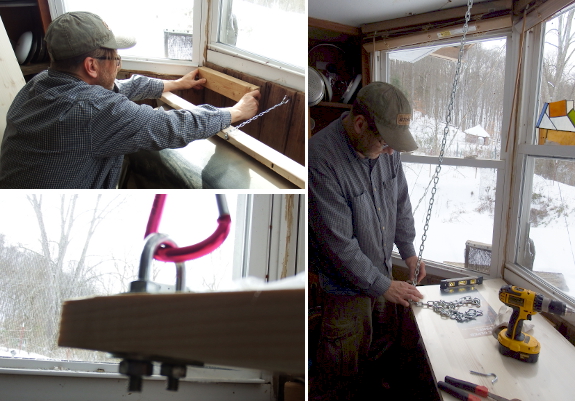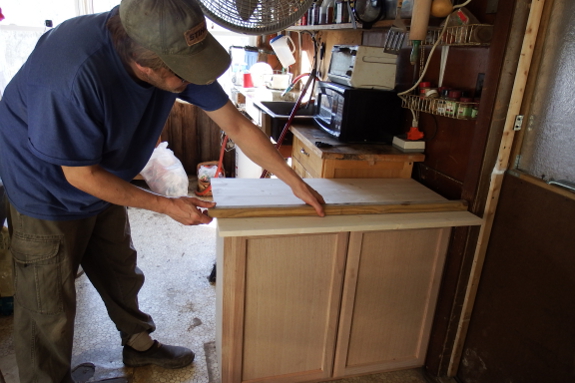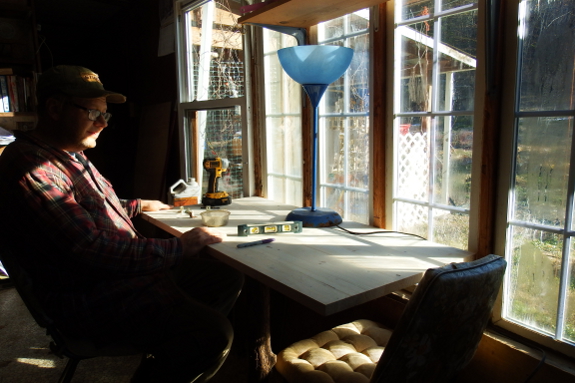
How thick does a board need to be for homemade furniture?

 We've
been having fun with amateur furniture-making this winter and are
learning a lot in the process. For example, what's the optimal board
thickness for a table- or countertop? The answer seems to depend on how
the board will be supported. Atop our marked-down cabinet,
we easily got away with a 3/4-inch-thick board because the thin
countertop is supported over nearly its entire lower surface with the
cabinet edges. Even a half-inch board might have worked as well.
We've
been having fun with amateur furniture-making this winter and are
learning a lot in the process. For example, what's the optimal board
thickness for a table- or countertop? The answer seems to depend on how
the board will be supported. Atop our marked-down cabinet,
we easily got away with a 3/4-inch-thick board because the thin
countertop is supported over nearly its entire lower surface with the
cabinet edges. Even a half-inch board might have worked as well.
On the other hand, a 3/4"
board wasn't good enough for our bathtub counter project (pictured at
the top of this post). We got the whole thing pretty much assembled,
then had to take it back apart when we realized that a board hung from
chains (for easy removal when the tub flips down) needs to be considerably thicker than three-quarters of an inch. I didn't even go so far
as to test the countertop with our heavy stand mixer --- just Mark
pressing down in the middle proved we'd either need a thicker board or
would have to build a frame underneath to prevent bowing.
 How about our 1-inch-thick tabletop?
That board has done very well supported on the back edge plus on two
legs along the front edge despite being a full four feet long by two
feet wide. So that's definitely a thick board that will go the distance.
Here's hoping using a similar product for our hanging counter will do
the trick as well.
How about our 1-inch-thick tabletop?
That board has done very well supported on the back edge plus on two
legs along the front edge despite being a full four feet long by two
feet wide. So that's definitely a thick board that will go the distance.
Here's hoping using a similar product for our hanging counter will do
the trick as well.
Want more in-depth information? Browse through our books.
Or explore more posts by date or by subject.
About us: Anna Hess and Mark Hamilton spent over a decade living self-sufficiently in the mountains of Virginia before moving north to start over from scratch in the foothills of Ohio. They've experimented with permaculture, no-till gardening, trailersteading, home-based microbusinesses and much more, writing about their adventures in both blogs and books.
Want to be notified when new comments are posted on this page? Click on the RSS button after you add a comment to subscribe to the comment feed, or simply check the box beside "email replies to me" while writing your comment.

Stiffness depends on two factors; shape and material.
The resistance against bending of a solid board increases with the third power of the board thickness. So a 1 inch board resists bending 8 times better than a 1/2 inch board. The deflection of a board supported at the ends scales linearly with the size of the load and with the third power of the length of the span. These are fundamental properties of the geometry and true for all materials.
Wood being a natural material varies a lot in its properties. Both between species but also from tree to tree.
If a solid board is too heavy, two relatively thin sheets of plywood with a frame and some braces bonded or screwed between them can be almost as stiff as a solid board.